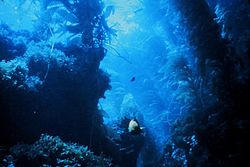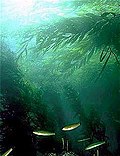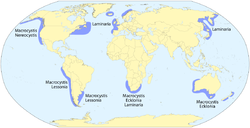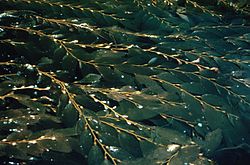Kelp forest
Kelp forests are a type of marine ecosystem that is present around colonies of kelp; they contain rich biodiversity. Kelp can stretch 2-30 meters or more (up to 60 m in Macrocystis pyrifera) from their anchors on the sea floor to the surface. It provides a vertical infrastructure that is home to many fish and invertebrate species. Kelp forests also often attract mammalian visitors, including whales, sea lions, sea otters, and SCUBA-diving humans.
Kelp forests draw their name from an analogy to forests on land.
In some places, sea urchins eat so many kelp plants that the kelp forest becomes an urchin barren.[1][2]
Ecosystem architecture
Giant kelp uses gas-filled floats to keep the plant suspended, allowing the kelp blades near the ocean surface to capture light for photosynthesis. The architecture of a kelp forest ecosystem is based on its physical structure, which influences the associated species that define its community structure. Structurally, the ecosystem includes three guilds of kelp and two guilds occupied by other algae:
- Canopy kelps include the largest species and often constitute floating canopies that extend to the ocean surface (e.g., Macrocystisand Alaria).
- Stipitate kelps generally grow a few meters above the sea floor and can grow in dense aggregations (e.g., Eisenia and Ecklonia).
- Prostrate kelps lie near and along the sea floor (e.g., Laminaria).
- The benthos is composed of other algal species (e.g., filamentous and foliose functional groups, articulated corallines) and sessile organisms along the ocean bottom.
- Encrusting coralline algae directly and often extensively cover ocean floor.
Multiple kelp species often co-exist within a forest; the term understory canopy refers to the stipitate and prostrate kelps. For example, a Macrocystis canopy may extend many meters above the seafloor towards the ocean surface, while an understory of the kelps Eisenia and Pterygophora reaches upward only a few meters. Beneath these kelps, a benthic assemblage of foliose red algae may occur. The dense vertical structure with overlying canopy forms a system of microenvironments similar to those observed in a terrestrial forest, with a sunny canopy region, a partially shaded middle, and darkened seafloor. Each guild has associated organisms, which vary in their levels of dependence on the habitat, and the assemblage of these organisms can vary with kelp morphologies. For example, in California, Macrocystis pyrifera forests, the nudibranch, Melibe leonina, and skeleton shrimp, Caprella californica, are closely associated with surface canopies; the kelp perch Brachyistius frenatus, rockfish Sebastes spp., and many other fishes are found within the stipitate understory; brittle stars and turban snails Tegula spp. are closely associated with the kelp holdfast, while various herbivores, such as sea urchins and abalone, live under the prostrate canopy; many seastars, hydroids, and benthic fishes live among the benthos; solitary corals, various gastropods, and echinoderms live over the encrusting coralline algae. In addition, pelagic fishes and marine mammals are loosely associated with kelp forests, usually interacting near the edges as they visit to feed on resident organisms.
Kelp Forest Media
A kelp forest at Cojo Anchorage near Point Conception, California.
Rockfish swimming around giant kelp
A diver in a kelp forest off the coast of California
Giant kelp uses gas-filled floats to keep the thallus suspended, allowing the kelp blades near the ocean surface to capture light for photosynthesis.
Sea urchins like this purple sea urchin can damage kelp forests by chewing through kelp holdfasts
The sea otter is an important predator of sea urchins
The jeweled top snail Calliostoma annulatum grazing on a blade of giant kelp
References
- ↑ Doug Simpson (February 2017). Underwater Barrens: Monitoring the fate of Southern Californian kelp requires a long view.. Natural History Magazine. https://naturalhistorymag.com/features/153361/underwater-barrens. Retrieved May 22, 2020.
- ↑ "With otters away, what keeps urchins at bay?". California Sea Grant. March 14, 2019. Archived from the original on September 29, 2020. Retrieved May 22, 2020.












